Ever wish you could get a clearer picture of what’s really going on inside your body? Not just a quick blood panel that says you’re “within range,” but real insight into why you feel the way you do. That’s what drew me to Lifeforce, a longevity platform built around biomarker testing, medical guidance, and personalized health plans.
I’m a 34-year-old dad juggling work, kids, and stress. Lately, I’ve noticed low energy, trouble focusing, and thinning hair that’s receding faster than I’d like. I wasn’t chasing a miracle fix. I just wanted to understand what was happening and how to take control of it.
I was especially curious about my hormone levels, particularly testosterone, and whether it could explain the fatigue, brain fog, or hair loss. More than anything, I wanted to get proactive about my health so I can feel better, learn more, and stay present for my kids.
In this review, I’ll walk through my full experience with Lifeforce. Consider me your tour guide from signup and blood draw to results, consultations, and recommendations. I’ll share what impressed me, what didn’t, and whether it’s worth it for someone in my position.
My Lifeforce Experience
So, first of all, I’ll just admit up front that I go a bit googly-eyed when it comes to anything medical. Even going for my yearly physical leaves me feeling a bit intimidated. So, while I was looking for something that could help me seize control, I was also anxious that I would need a lot of hand-holding throughout the Lifeforce process.
Instead, I was pleasantly surprised by how easy everything was! It’s clear they’ve spent a lot of time honing their message and making sure nobody leaves feeling confused, and that holds true throughout every stage of the process.
When I first read the “What to Expect” section on their site I was reassured I’d be “guided” rather than “self-directed”.

Signing Up
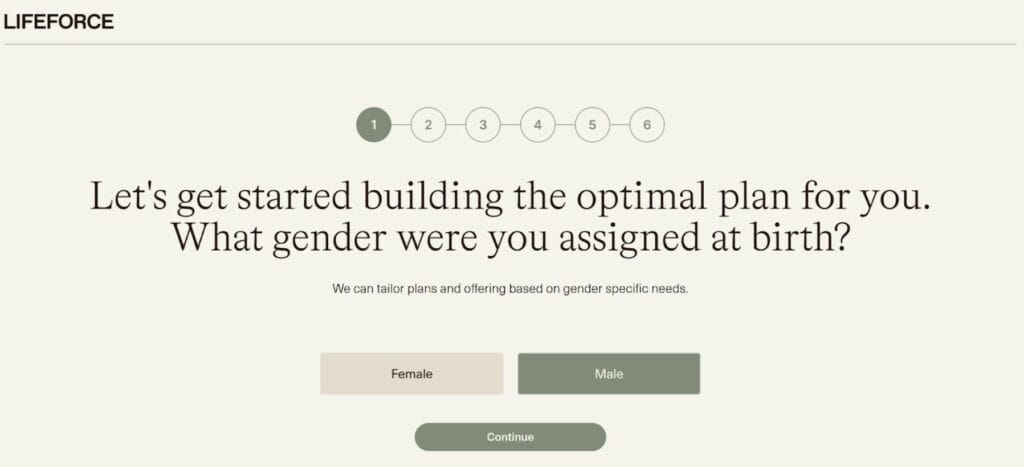
The Lifeforce signup process took me less than ten minutes, all told. First, you must go through a registration workflow where you give them basic details about yourself as well as fill out a short medical history form and list any current supplements or medications. There was no hunting for hidden links or confusing checkouts. All in all, an extremely smooth experience that had me booking a blood draw on my calendar in minutes.
Scheduling and Sample Collection
Lifeforce offers both at-home and clinic-based blood draws, though the former was unfortunately not available in my location. I booked my draw at a Quest Diagnostics location near me instead. It took about a week in total from the moment I placed the order to the day my blood was drawn.
The blood draw itself felt like a real medical experience, not one of those quick finger-prick tests. It’s a full venous draw, meaning you’re giving several vials of blood for a comprehensive analysis. How smooth it goes will depend on your location and the skill of your phlebotomist, but mine was efficient and professional.
I’ll be honest…I’m not great with needles, so I came prepared. I hydrated like crazy that morning, grabbed a small snack beforehand, and still found myself gripping the chair a little tighter than I’d like to admit. But the process was over in just a few minutes, and walking out I felt surprisingly accomplished. I’d taken a real first step!
Turnaround Time for Results
My results were ready in about six business days, which was faster than I expected. Once the lab work was processed, I got an email letting me know everything was ready to view. That small notification honestly gave me a rush of curiosity. I’d spent the week wondering what my numbers might reveal, so being able to open the report felt like finally being able to unwrap the box beneath the tree.
The process from draw to delivery felt seamless. I never had to chase an update or log in just to check on progress; Lifeforce kept me in the loop the whole way. For something that involves sending your blood off to a lab, it all moved quickly and efficiently.
Dashboard and Interface
When I finally opened my results, I appreciated that nothing felt dumped on me at once. The data was there, ready to explore, but it didn’t feel overwhelming. The dashboard is clean, intuitive, and doesn’t bury you in jargon.
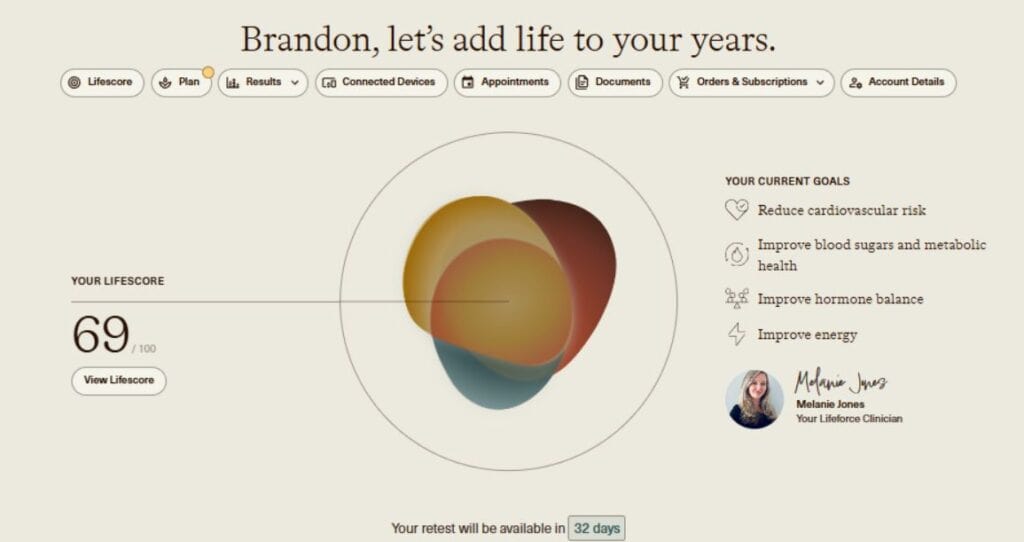
The first thing I noticed was my Lifescore: 69 out of 100. It’s a single number that sums up your overall biomarker health, factoring in everything from cardiovascular risk and metabolic function to hormones and energy levels. Next to it were my current goals:
- Reduce cardiovascular risk
- Improve blood sugar and metabolic health
- Improve hormone balance
- Improve energy
Digging deeper, Lifeforce breaks down each individual biomarker in a way that feels approachable. For example, my DHEA-S levels were low, and instead of just throwing a number at me, the platform explained what that meant: DHEA is a precursor hormone that supports testosterone and cognitive function, and low levels can affect both. Right beside that, my LDL cholesterol was flagged slightly above optimal, and the dashboard clearly outlined possible causes, from diet to lifestyle factors like stress and sleep.
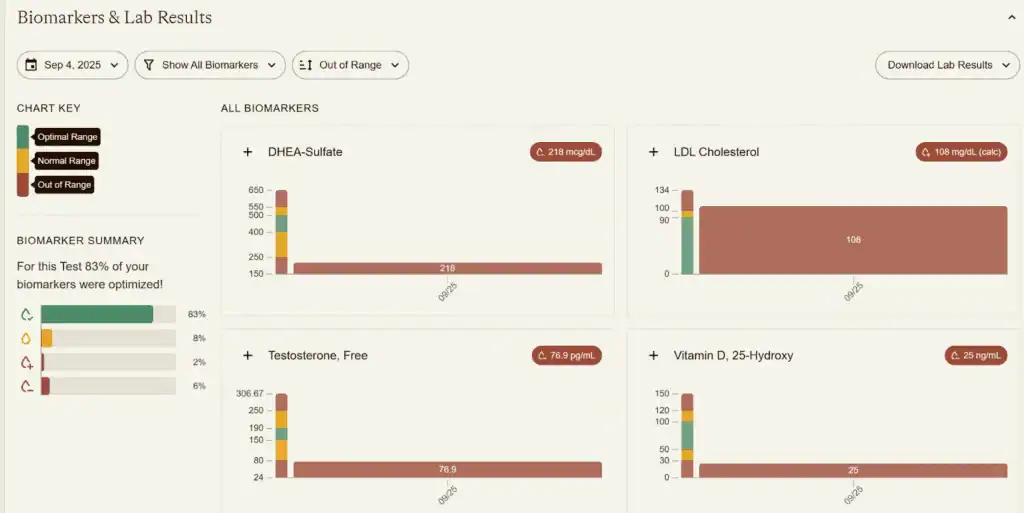
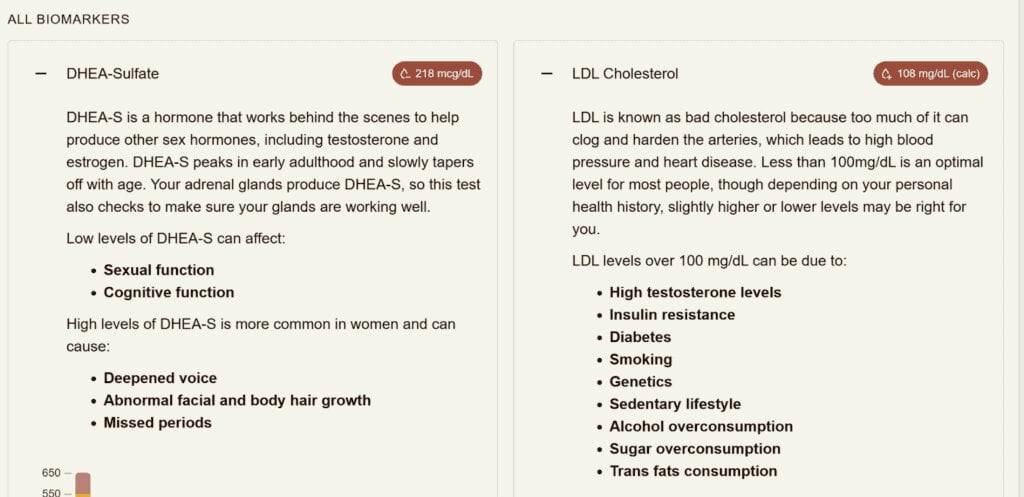
Overall, the experience felt empowering. It wasn’t just data for data’s sake. The dashboard made it obvious what mattered and why, so by the time I got on my consultation call, I already had a sense of what was going on and what questions I wanted to ask.
Telehealth Consultation
A few days after my results came in, I met virtually with my Lifeforce clinician for a 30-minute call. It was a true consultation, not a quick summary. We went through my biomarkers line by line, discussing what each meant in context with how I’d been feeling. .
What stood out right away was how personal it felt. My clinician, Melanie Jones, didn’t rush or rely on a script. She connected the dots between my slightly low DHEA levels, borderline LDL, and the fatigue I’d been describing. Rather than prescribing something immediately, she framed it as a foundation-building phase. We needed to get my lifestyle dialed in first, then see how my body responds before considering anything more aggressive.
The action plan that followed was surprisingly specific:
- Cut back pastries and sweets to once per week to help stabilize energy and lower inflammation.
- Get back to consistent exercise, even if that just means dusting off the treadmill.
- Incorporate more healthy fats like avocado, olive oil, nuts, and salmon for hormone and heart health.
- Manage stress and prioritize sleep, since both directly influence hormone balance and recovery.
She also suggested a few core supplements: Vitamin D+K, Omega-3, and DHEA, the last one being optional for adrenal and stress support. Each recommendation came with reasoning tied to my own numbers, not a one-size-fits-all list.
So far…no googly eyes! I didn’t feel like I was stuck in a whirlwind like I often do at the doctor’s office, and I also didn’t feel sold to.
Instead, I felt understood.
Ongoing Optimization & Personalized Care
After the initial consultation, Lifeforce doesn’t just disappear. They schedule regular check-ins (typically every three months) to review new lab results, assess progress, and adjust your plan. These aren’t quick “everything look good?” calls either. Each one feels like a genuine health strategy session. The same clinician reviews your latest biomarkers, listens to how you’ve been feeling, and helps fine-tune your next steps based on data and feedback.
Between those lab cycles, you’re paired with a health coach who acts as the glue holding everything together. And let me tell you, this is where the “concierge” side of Lifeforce really came through.
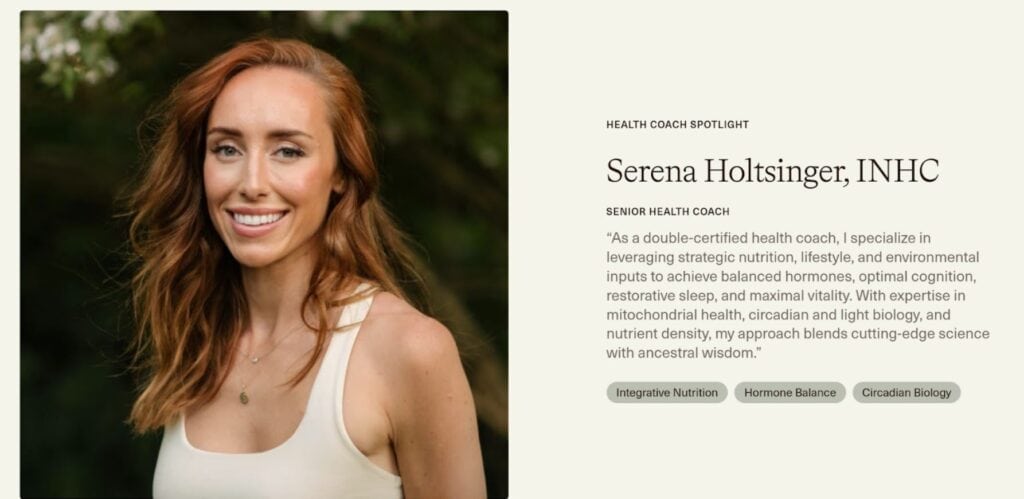
My health coach, Serena, was genuinely excited to meet me and put together a plan that worked, not just on paper but for what my life actually was like. The session dove into the daily stuff like sleep routines, habits I want to kick, diet, stress management, hobbies and more. She gave me tangible advice about working in more sunlight exposure, specifically early in the morning, and “oyster maxing” (yum!). In other words, this was extremely personalized. In fact, both of us blinked and realized we’d gone over our time.
By the end, we’d developed a plan and a real sense of partnership, which looking back has felt nearly as important as the plan itself. Now, I had someone I respected that I needed to be accountable to.
Longevity-Focused Planning
What I like most is that Lifeforce doesn’t frame your plan around “fixing what’s wrong.” It’s about optimizing over time. They connect supplement protocols, hormone support, and nutrition adjustments into a broader strategy for long-term vitality. Instead of a one-and-done fix, it feels like building a personalized operating manual for your body, tracking what’s working and what isn’t quarter by quarter.
My biggest takeaway?
The ongoing care feels human! Nothing about it comes off as sales-driven or templated. The team seems genuinely invested in helping you understand the why behind each recommendation. The cadence of touchpoints keeps you accountable without being overwhelming, and the dashboard reminders make it easy to stay on track between calls.
At the time of this writing (just after my health coach consultation), I’ve already noticed real change. My energy levels have picked up noticeably, and I’m sleeping deeper. What’s made the biggest difference has honestly been setting aside dedicated time to get outside in the morning and preserving some time in the evening for analog activities like drawing or reading.
Lifeforce Pros & Cons
Pros
- Comprehensive testing: The biomarker panel is legitimately broad, covering hormones, vitamins, inflammation, metabolic health, and more. It gives you a full snapshot of what’s happening internally instead of just a handful of numbers.
- Convenience: The at-home blood draw is a huge win. Having a licensed nurse come right to your door makes the whole thing feel simple and professional.
- Clarity of results: The dashboard is clean, easy to navigate, and avoids heavy medical jargon. Seeing “optimal,” “normal,” and “out of range” markers side by side makes it intuitive to understand where you stand.
- Personalized follow-through: The clinician and health coach sessions add real value. They help you interpret the data and turn it into actionable next steps instead of leaving you guessing.
- Ongoing tracking: Quarterly retesting makes it easy to spot trends and see whether your changes are working. Over time, it feels more like continuous improvement than a one-off lab test.
Cons
- Price: It’s expensive. Between the initial panel and the monthly membership, it’s a financial commitment that won’t fit everyone’s budget.
- Insurance: None of it is covered, which can be a sticking point if you’re used to routine labs being handled by your provider.
- Availability: Home phlebotomy isn’t offered in every area, so depending on where you live, you might have to visit a partner lab instead.
I think it’s worth emphasizing that Lifeforce shouldn’t replace your primary care provider. In fact, you could almost list “it works too well” as a con. It’s easy to get so invested in the data and ongoing support that you forget it’s meant to complement traditional care, not replace it.
Who Lifeforce is Best For
Lifeforce is ideal for people who already take their health seriously but want to dig deeper. If you’re into training, nutrition, recovery, or general optimization and want hard data to back up how you feel, this service fits perfectly. It’s also great for anyone in their 30s or 40s who’s starting to notice shifts in energy, focus, sleep, or hormone balance and wants to get ahead of it instead of waiting for symptoms to get worse.
But, if you’re dealing with a chronic medical condition or looking for diagnostic testing to uncover the root of specific health issues, Lifeforce probably isn’t the right fit. It’s built around optimization and performance, not medical treatment. Likewise, if you’re unlikely to act on the recommendations or maintain consistent follow-ups, this isn’t for you. The true difference maker here is in finding where you stand and then taking steps (alongside the people who know where to step) to improve yourself!
- Best Luxury Flower Deliveries - December 4, 2025
- Top Ollie Dog Food Subscription Alternatives - November 28, 2025
- The Best Wine Subscription to Give as a Gift: My Top 6 Picks - November 24, 2025
